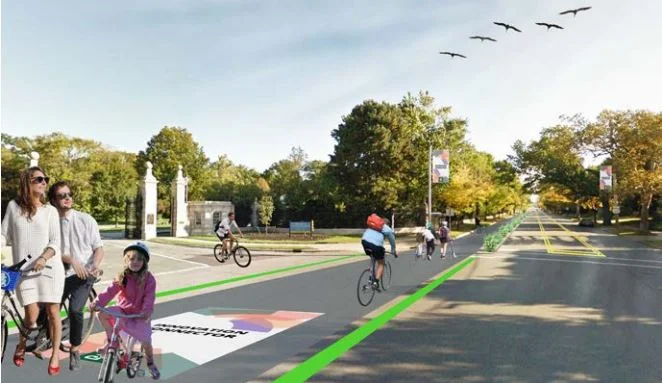Despite taking up little land in a metro area, mixed-use, walkable centers have an outsized and regionally significant impact on the local economy.
Cleveland Heights recognized with 2018 best Complete Streets policy
Ohio Transportation Academy Workshop III: Effective Strategies for Building Local Transportation Campaigns
Members of the 2017 Ohio Transportation Leadership Academy recently completed the third workshop of the Ohio Transportation Academy. Hosted by GOPC and Transportation for America (T4A), the workshop brought together public, private, and nonprofit leaders from Cincinnati, Delaware, Toledo, Lorain, Cleveland, and Akron.
Why Ohio’s business leaders want walkable downtowns
Hundreds of American companies see unique competitive advantages to being located in a walkable downtown neighborhood. These locations are helping companies attract and retain talented workers, build their brand and corporate identity, support creative collaboration, be closer to partners, consolidate operations, and support triple-bottom line business outcomes. Core Values: Why American Companies are Moving Downtown is a new report out today from Smart Growth America in partnership with Cushman & Wakefield and the George Washington University School of Business’ Center for Real Estate and Urban Analysis. The report surveys nearly 500 companies that have moved to or expanded in walkable downtowns over the past five years, as well as interviews with 45 senior-level staff at those companies. The report sheds light on why these companies chose a walkable downtown and what they looked for when making their decision.
“These companies chose a walkable downtown location to help them better compete for talent and resources,” said Geoff Anderson, President and CEO of Smart Growth America. “That tells us two things. First, that creating these kinds of places is a crucial economic development strategy for cities. And second, that companies which haven’t considered a walkable location may be at risk of falling behind.”
In addition to explaining the reasons why they moved downtown, company leaders also outlined what they looked for when choosing a new location. Many interviewees said they wanted their offices to be close to restaurants, shops, and entertainment options, and accessible by a variety of transportation options. Great office space was another important factor. A warm welcome on the part of the city, and a clean and safe environment were also influential factors when deciding where to move.
The report’s survey includes 53 companies from Ohio, including General Electric, BrownFlynn, Dakota Software, Nationwide and Deloitte. These are just some of the many companies that have moved to walkable downtowns in the state in recent years.
The full report, along with a full list of companies included in this survey and an interactive map showing where they moved, is available on Smart Growth America’s website at www.smartgrowthamerica.org/core-values.
Smart Growth America is the only national organization dedicated to researching, advocating for and leading coalitions to bring better development to more communities nationwide. From providing more sidewalks to ensuring more homes are built near public transportation or that productive farms remain a part of our communities, smart growth helps make sure people across the nation can live in great neighborhoods. Learn more at www.smartgrowthamerica.org.
Join the kickoff event: A look at companies moving to downtowns
Over the past five years, hundreds of companies across the United States have moved to and invested in walkable downtowns. Why did companies choose these places? And what features did they look for when picking a new location? On June 18, national non-profit Smart Growth America will release new research that seeks to answer both these questions. "Core Values: Why American Companies are Moving Downtown" surveys nearly 500 companies that have moved to or invested in walkable downtowns over the past five years, and includes interviews with more than 40 senior-level staff at those companies. There are 53 companies in Ohio’s urban cores included in the analysis, including General Electric, BrownFlynn, Dakota Software, Nationwide and Deloitte. Ohio metropolitan areas mentioned in the report include Cincinnati, Cleveland, Columbus, Dayton and Toledo.
As part of the launch of this new research, Smart Growth America will hold a kickoff panel discussion in Washington, DC. The event will be livestreamed on the web, and you can watch it as it happens on Thursday, June 18, 2015 starting at 9:00 AM EDT. Register to join:
Joining the panel will be Geoff Anderson, President and CEO of Smart Growth America; Paula Munger, Director of Business Line Research and Brian Dawson, Senior Managing Director and Market Leader for the Washington, DC region for Cushman & Wakefield; Michael Deemer, Executive Vice President, Business Development at the Downtown Cleveland Alliance; Mark Fisher, Vice President of Government Relations and Policy Development for the Indianapolis Chamber of Commerce; Brad Lacy, President & Chief Executive Officer of the Conway, AR Chamber of Commerce; Jim Reilly, Vice President, Corporate Communications at Panasonic; and Amy Ronneberg, Chief Financial Officer at Be the Match.
The conversation in the report as well as on the panel will provide an overview of why these companies chose to move downtown, and what they looked for when considering a new location. The event will also provide ideas for cities about how they can create the kinds of places these companies seek.
Have questions for the panelists ahead of time? Tweet them to @SmartGrowthUSA or use the hashtag #CoreValues.
We hope you’ll join us for the live event on June 18.
Where Ohio is Sprawling and What It Means
Some areas in Ohio are sprawling, some are building in compact, connected ways, and the difference between the two strategies has implications for millions of Ohioans’ day-to-day lives.
Measuring Sprawl 2014, released today by national advocacy group Smart Growth America, ranks the most sprawling and most compact areas of the country. The new report evaluates development patterns in 221 major metropolitan areas and their counties based on four factors: density, land use mix, street connectivity and activity centering. Each metro area received a Sprawl Index score based on these factors.*
Here is how regions in Ohio ranked:
| Metropolitan Statistical Area | National Rank | Composite (total) score |
| Canton-Massillon, Ohio | 93 | 106.99 |
| Akron, Ohio | 111 | 103.15 |
| Dayton, Ohio | 116 | 101.48 |
| Toledo, Ohio | 117 | 100.90 |
| Columbus, Ohio | 138 | 93.00 |
| Cleveland-Elyria-Mentor, Ohio | 153 | 85.62 |
| Cincinnati-Middletown, OH-KY-IN | 166 | 80.75 |
| Youngstown-Warren-Boardman, OH-PA | 175 | 78.08 |
* The four factors were combined in equal weight to calculate each area’s Sprawl Index score. The average Index is 100, meaning areas with scores above 100 tend to be more compact and connected, and areas with scores below 100 are more sprawling. Visit Smart Growth America to view the full rankings >>
The new report also examines how different development patterns relate to the quality of life in these areas—and the differences are startling. People in compact, connected areas have greater upward economic mobility than their peers in sprawling areas. That is, a child born in the bottom 20% of the income scale has a better chance of rising to the top 20% of the income scale by age 30.
People in compact, connected metro areas spend less on the combined expenses of housing and transportation. Housing costs are higher in compact, connected areas, but these higher costs are more than offset by lower transportation costs. People in compact, connected metro areas also have more transportation options. People in these areas tend to walk more, take transit more, own fewer cars and spend less time driving than their peers in sprawling areas.
Finally, people in compact, connected areas have longer, healthier, safer lives. Life expectancy is greater in compact, connected areas, and driving rates (and their associated risk of a fatal collision), body mass index, air quality and violent crime all contribute to this difference.
Outcomes like this are why Greater Ohio Policy Center is dedicated to helping Ohio’s regions develop in a more sustainable way. Helping people in Ohio live healthier, wealthier, happier lives is why we do the work we do, and smarter development is a key part of making that happen.
Read the full findings of Measuring Sprawl 2014 and see how every major metro area in the country compares when it comes to sprawl at www.smartgrowthamerica.org/measuring-sprawl.
Piqua Recognized as Top 10 National Leader in Creating Complete Streets
Greater Ohio congratulates the City of Piqua, Ohio on receiving national recognition for developing complete streets. According to the National Complete Streets Coalition, a program of national non-profit Smart Growth America (SGA), the complete streets policy that Piqua passed last year ranked 9th in the country, out of more than 80 cities, states, and regions that passed similar policies in 2013. SGA says this makes Piqua “a national leader in making streets safer and more convenient for everyone who uses them.” Complete streets policies “encourage planners and engineers to design and build streets that are safe and convenient for everyone, regardless of age, ability, income or ethnicity, and no matter how they travel,” according to SGA.
SGA’s rankings are “intended to celebrate the communities that have done exceptional work in crafting comprehensive policy language over the past year.” The evaluators determine scores based on 10 technical elements of an ideal Complete Streets policy. The communities with the top-scoring policies of 2013 are:
1. Littleton, MA
2. Peru, IN
3. Fort Lauderdale, FL
4. Auburn, ME (tie)
4. Lewiston, ME (tie)
6. Baltimore County, MD
7. Portsmouth, NH
8. Muscatine, IA
9. Piqua, OH
10. Oakland, CA
11. Hayward, CA (tie)
11. Livermore, CA (tie)
11. Massachusetts Department of Transportation (tie)
14. Cedar Falls, IA (tie)
14. Waterloo, IA (tie)
More information about the winning policies and evaluation criteria, and what Piqua scored, is available here.
Nationwide, a total of 610 jurisdictions in 48 states have Complete Streets policies in place.
Sprawl costs Ohio families and regional economy, new report shows
The twelve counties that make up Northeast Ohio are home to a community that prides itself on its public art, theaters, parks and hiking trails, and home-grown businesses. Now, a new vanguard of engaged residents are working with a local organization to make Northeast Ohio even better.
The first step in this process is to examine what’s working in Northeast Ohio’s communities, and a new survey from the Northeast Ohio Sustainable Communities Consortium (NEOSCC) does just that. NEOSCC released its Conditions & Trends platform on Tuesday, during the Consortium’s monthly meeting in Youngstown. The extensive inventory of Northeast Ohio’s assets, challenges and year-over-year trends provides a comprehensive assessment of how the region could improve. Prominent among the findings is the fact that Northeast Ohio has spread out over the past several decades, and that this trend is damaging the region’s economy. Between 1979 and 2006, the average number of people per acre of developed land in Northeast Ohio declined by 22.96% with population shifting from urban areas like Cleveland and Akron to more sparsely populated ones.
The region’s economy has faced challenges as a result. Cities and towns in the region are struggling to support the cost of roads and sewers in this sparse development, as these expenses have far outpaced public revenues from employment growth, per capita wage growth, and property value increases. The region’s housing market is weak, as supply exceeds demand and many homes stand vacant. Yet there’s a shortage of housing that meets the needs of people with disabilities and elderly residents, and the area’s sparse population distribution makes public transportation difficult to support. In addition, as many residents move to the suburbs low-income families who cannot afford to move are often left in areas that now struggle to afford public services. All of this weighs on taxpayers. As the Cleveland Plain Dealer explained, the region’s development strategy of recent decades has imposed “higher costs of living on Northeast Ohioans through longer commuting distances to work, gas taxes, user fees, sales taxes and other outlays.”
These findings are meant to inform the region’s planning, and the NEOSCC’s platform also provides a way forward. The platform encourages visitors to weigh in and discuss the issues online, and provides space for visitors to comment on each of the substantive issues areas.
NEOSCC’s work is made possible by a Sustainable Communities Regional Planning Grant from the U.S. Department of Housing and Urban Development (HUD). HUD’s grant program is part of the federal Partnership for Sustainable Communities, a collaboration between HUD, the U.S. Department of Transportation and the Environmental Protection Agency to coordinate federal spending in smarter ways, to bring local government spending under control and to help regions understand the true cost of long-term decisions on where development should occur.







